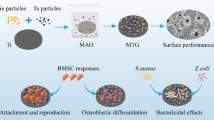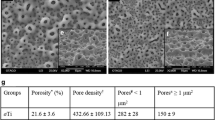Abstract
An antibacterial and bioactive titanium (Ti)-based material was developed for use as a bone substitute under load-bearing conditions. As previously reported, Ti metal was successively subjected to NaOH, CaCl2, heat, and water treatments to form a calcium-deficient calcium titanate layer on its surface. When placed in a simulated body fluid (SBF), this bioactive Ti formed an apatite layer on its surface and tightly bonded to bones in the body. To address concerns regarding deep infection during orthopedic surgery, Ag+ ions were incorporated on the surface of this bioactive Ti metal to impart antibacterial properties. Ti metal was first soaked in a 5 M NaOH solution to form a 1 μm-thick sodium hydrogen titanate layer on the surface and then in a 100 mM CaCl2 solution to form a calcium hydrogen titanate layer via replacement of the Na+ ions with Ca2+ ions. The Ti material was subsequently heated at 600 °C for 1 h to transform the calcium hydrogen titanate into calcium titanate. This heat-treated titanium metal was then soaked in 0.01–10 mM AgNO3 solutions at 80 °C for 24 h. As a result, 0.1–0.82 at.% Ag+ ions and a small amount of H3O+ ions were incorporated into the surface calcium titanate layers. The resultant products formed apatite on their surface in an SBF, released 0.35–3.24 ppm Ag+ ion into the fetal bovine serum within 24 h, and exhibited a strong antibacterial effect against Staphylococcus aureus. These results suggest that the present Ti metals should exhibit strong antibacterial properties in the living body in addition to tightly bonding to the surrounding bone through the apatite layer that forms on their surfaces in the body.








Similar content being viewed by others
References
Kim H-M, Miyaji F, Kokubo T, Nakamura T. Preparation of bioactive Ti and its alloys via simple chemical surface treatment. J Biomed Mater Res. 1996;32:409–17.
Yan W-Q, Nakamura T, Kobayashi M, Kim H-M, Miyaji F, Kokubo T. Bonding of chemically treated titanium implants to bone. J Biomed Mater Res. 1997;37:267–75.
Nishiguchi S, Fujibayashi S, Kim H-M, Kokubo T, Nakamura T. Biology of alkali- and heat-treated titanium metal. J Biomed Mater Res. 2003;67A:26–35.
Kizuki T, Takadama T, Matsushita T, Nakamura T, Kokubo T. Preparation of bioactive Ti metal surface enriched with calcium ions by chemical treatment. Acta Biomater. 2010;6:2836–42.
Yamaguchi S, Takadama H, Matsushita T, Nakamura T, Kokubo T. Apatite-forming ability of Ti–15Zr–4Nb–4Ta alloy induced by calcium solution treatment. J Mater Sci Mater Med. 2010;21:439–44.
Fukuda A, Takemoto M, Saito T, Fujibayashi S, Neo M, Yamaguchi S, Kizuki T, Matsushita T, Niinomi M, Kokubo T, Nakamura T. Bone bonding bioactivity of Ti metal and Ti–Zr–Nb–Ta alloys with Ca ions incorporated on their surfaces by simple chemical and heat treatment. Acta Biomater. 2011;7:1379–86.
Kawanabe K, Ise K, Goto K, Akiyama H, Nakamura T, Kaneuji A, Sugimori T, Matsumoto T. A new cementless total hip arthroplasty with bioactive titanium porous-coating by alkaline and heat treatment: average 4.8-year result. J Biomed Mater Res. 2009;90B:476–81.
So K, Kaneuji A, Matsumoto T, Matsuda S, Akiyama H. Is the bone-bonding ability of a cementless total hip prosthesis enhanced by alkaline and heat treatment? Clin Orthop Relat Res. 2013;471(12):3847–55.
Hamilton H, Jamieson J. Deep infection in total hip arthroplasty. Can J Surg. 2008;51:111–7.
Hu S, Chang J, Liu M, Ning C. Study on antibacterial effect of 45S5 Bioglass. J Mater Sci Mater Med. 2009;20:281–6.
Zhang D, Leppäranta O, Munukka E, Ylänen H, Viljanen MK, Eerola E, Hupa M, Hupa L. Antibacterial effects and dissolution behavior of six bioactive glasses. J Biomed Mater Res. 2010;93A:475–83.
Chen Y, Zheng X, Xie Y, Ji H, Ding C, Li H, Dai K. Silver release from silver-containing hydroxyapatite coatings. Surf Coat Tech. 2010;205:1892–6.
Lu X, Zhang B, Wang Y, Zhou X, Weng J, Qu S, Feng B, Watari F, Ding Y, Leng Y. Nano-Ag-loaded hydroxyapatite coatings on titanium surfaces by electrochemical deposition. J R Soc Interface. 2010;6:1–11.
Qu J, Lu X, Li D, Ding Y, Leng Y, Weng J, Qu S, Feng B, Watari F. Silver/hydroxyapatite composite coatings on porous titanium surfaces by sol-gel method. J Biomed Mater Res Part B. 2011;97B:40–8.
Chen W, Liu Y, Courtney HS, Bettenga M, Agrawal CM, Bumgardner JD, Ong JL. In vitro anti-bacterial and biological properties of magnetron co-sputtered silver-containing hydroxyapatite coating. Biomater. 2006;27:5512–7.
Miola M, Ferraris S, Di Nunzio S, Robotti PF, Bianchi G, Fucale G, Maina G, Cannas M, Gatti S, Massé A, Vitale Brovarone C, Vern E. Surface silver-doping of biocompatible glasses to induce antibacterial properties. Part II; plasma sprayed glass-coatings. J Mater Sci Mater Med. 2009;20:741–9.
Noda I, Miyaji F, Ando Y, Miyamoto H, Shimazaki T, Yonekura Y, Miyazaki M, Mawatari M, Hotokebuchi T. Development of novel thermal sprayed antibacterial coating and evaluation of release properties of silver ions. J Biomed Mater Res Part B. 2009;89B:456–65.
Stigter M, de Groot K, Layrolle P. Incorporation of tobramycin into biomimetic hydroxyapatite coating on titanium. Biomater. 2002;23:4143–53.
Inoue Y, Uota M, Torikai T, Watari T, Noda I, Hotokebuchi T, Yada M. Antibacterial properties of nanostructured silver titanate thin films formed on a titanium plate. J Biomed Mater Res. 2010;92A:1171–80.
Yada M, Inoue Y, Akihito G, Noda I, Torikai T, Watari T, Hotokebuchi T. Apatite-forming ability of titanium compound nanotube thin films formed on a titanium metal plate in a simulated body fluid. Col Surf B. 2010;80:116–24.
Kokubo T, Yamaguchi S. Bioactive Ti metal and its alloys prepared by chemical treatments: state-of-the-art and future trends. Adv Eng Mater. 2010;12:B579–91.
Kokubo T, Takadama H. How useful is SBF in predicting in vivo bone bioactivity? Biomater. 2006;27:2907–15.
Yamaguchi S, Takadama H, Matsushita T, Nakamura T, Kokubo T. Cross-sectional analysis of the surface ceramic layer developed on Ti metal by NaOH-heat treatment and soaking in SBF. J Ceram Soc Japan. 2009;117:1126–30.
Margad JrE, de Abreu MAS, Pravia ORC, Marinkovic BA, Jardim PM, Rizzo FC, Araújo AS. A study on the structure and thermal stability of titanate nanotubes as a function of sodium content. Solid State Sci. 2006;8:888–900.
Author information
Authors and Affiliations
Corresponding author
Rights and permissions
About this article
Cite this article
Kizuki, T., Matsushita, T. & Kokubo, T. Antibacterial and bioactive calcium titanate layers formed on Ti metal and its alloys. J Mater Sci: Mater Med 25, 1737–1746 (2014). https://doi.org/10.1007/s10856-014-5201-9
Received:
Accepted:
Published:
Issue Date:
DOI: https://doi.org/10.1007/s10856-014-5201-9




